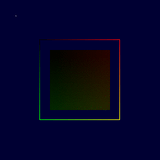Search Results
7/17/2025, 9:20:06 PM
>>16726618
>explain quaternions to me
>i want to learn it for 3d [rotations]
listen up, because this isn't a schizo post.
i can't motivate the quaternion rotation formula for you intuitively.
however i can show you how it's equivalent to a coordinate-free formula for 3d vector rotation.
it is important to note at the outset that rotation using quaternions is a special result, and that quaternions do not encode rotations in general.
that being said, the derivation of the quaternion rotation equation proceeds by starting off with a bunch of quaternion definitions and then showing that a particular function is equivalent to the (Rodriguez) vector rotation formula.
let's start by examining our end goal, the coordinate-free 3d vector rotation formula. a coordinate-free formulation of the rotation of position vector [math]\vec{r}[/math] about the origin can be parameterized by an axis [math]\hat{\vec{n}}[/math] (represented here by a unit vector) and angle [math]\theta[/math]. the resulting rotated vector is
[eqn]
R(\vec{r}, \hat{\vec{n}}, \theta) = \vec{r}_\perp \cos \theta + [\hat{\vec{n}} \times \vec{r}] \sin\theta +\vec{r}_\parallel
[/eqn]
where [math]\vec{r}_\perp[/math] and [math]\vec{r}_\parallel[/math] are the perpendicular and parallel parts of vector [math]\vec{r}[/math] w.r.t. the axis [math]\hat{\vec{n}}[/math]. this equation is pretty easy to intuit; the perpendicular part rotates in the plane perpendicular to the axis, and the parallel part doesn't change.
so with that in mind, we'll start from the definitions of quaternions and derive the preceding equation in a special case.
>explain quaternions to me
>i want to learn it for 3d [rotations]
listen up, because this isn't a schizo post.
i can't motivate the quaternion rotation formula for you intuitively.
however i can show you how it's equivalent to a coordinate-free formula for 3d vector rotation.
it is important to note at the outset that rotation using quaternions is a special result, and that quaternions do not encode rotations in general.
that being said, the derivation of the quaternion rotation equation proceeds by starting off with a bunch of quaternion definitions and then showing that a particular function is equivalent to the (Rodriguez) vector rotation formula.
let's start by examining our end goal, the coordinate-free 3d vector rotation formula. a coordinate-free formulation of the rotation of position vector [math]\vec{r}[/math] about the origin can be parameterized by an axis [math]\hat{\vec{n}}[/math] (represented here by a unit vector) and angle [math]\theta[/math]. the resulting rotated vector is
[eqn]
R(\vec{r}, \hat{\vec{n}}, \theta) = \vec{r}_\perp \cos \theta + [\hat{\vec{n}} \times \vec{r}] \sin\theta +\vec{r}_\parallel
[/eqn]
where [math]\vec{r}_\perp[/math] and [math]\vec{r}_\parallel[/math] are the perpendicular and parallel parts of vector [math]\vec{r}[/math] w.r.t. the axis [math]\hat{\vec{n}}[/math]. this equation is pretty easy to intuit; the perpendicular part rotates in the plane perpendicular to the axis, and the parallel part doesn't change.
so with that in mind, we'll start from the definitions of quaternions and derive the preceding equation in a special case.
Page 1
